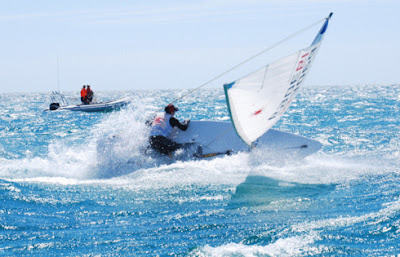Life for me these days has become like a plate spinning routine. I've got at least 8 plates spinning at the moment and my time is spent running around keeping the plates spun up while circus music is playing in the background. It's crazy, it's hectic, and this blog is being put on the back burner. Having said that, a lot has happened since I last chimed in.
Private Pilot
 |
| Cessna 150 Super in Action! |
Thanks to my incredible success with Apple stock and my gracious instructors, I can finally afford my private pilot certificate. I'm flying in what I call the Cessna 150 Super! It has an 150 hp Lycoming O-320 instead of a quaint 100 hp O-200. As one of my A&P (airframe and powerplant for aircraft) instructors once said, "If more is better, then way too much is just about adequate."
Because I've had a lot of experience at the controls thanks to all of my pilot friends, simulator time, and Pterodactyl solo flights thanks to Dave Froble, it hardly took me any time until I soloed the red and white Super Cessna. At first, I found that flying the plane was easier than taxing it. I have all my night requirements out of the way, and most of my solo cross country requirements finished. At the moment, I have somewhere around 23 logged hours (40 hours is required) and not a whole lot of requirements left. Why is it going so well for me? I'm not so sure, but I'll take it!
Paragliding
Many years ago, I fell in love with the idea of paragliding. You can have a flying rig that easily fits in the truck of a small car, drive to a nearby mountain or cliff, clip in, run forward, and join the birds in a thermal, soar along beautiful ocean cliffs, float by puffy, white clouds, and more. If you don't want to drive to a good launching hill, you can hook into a paramotor and use it's thrust to propel you into the air. No part of this description is an exaggeration.
 |
| Jason Shapiro takes me and my crazy hair for a flight! |
When people dream about flying, this is what they're dreaming about. To be brutally honest, this is way more fun than flying the Cessna 150. The old farts that at the airport that passionately insist that their kind of flying is the "real" kind of flying have no idea what their missing. You might plow through some turbulence with a "real" airplane, but you will never feel the wing lifting you off the ground, sucking you into a thermal or rocking you through a rotor. Flying a paraglider will force you to have a better understanding of what the air is doing and sadly, most "real" pilots are clueless in this department.
In the process of learning about paragliding and powered paragliding, I came across convicted criminal, liar, narcissist, and reckless powered paragliding pilot, Dell Schanze. Not knowing any better, I listened to him and believed his ridiculous claims. I built a website for him, in hope to help him start up a better and new powered paragliding organization, the WPPGA (World Powered Paragliding Association).
 |
| Not bad, considering most jail photos. |
The deal he made with me is that if I did that for him, he would give me lessons and equipment. After a while, I realized that all the horrific thing's that Schanze is responsible for is indeed true. I started to understand more about him and figured out what makes him tick and it was wrong. The man is faced with a mental illness, but he will go to extreme and radical lengths to deny it. I reluctantly continued to work on the website because I wanted gear and instruction and I didn't want all the time I spent on the website to go to waste. Then, Dell illegally jumped off a historical landmark in a small quiet town in Astoria Oregon with his speed wing, caused all sorts of havoc, and closed down their beach for paragliding. Adding insult in injury, I left Schanze in a hurry. Luckily, that website went to hell after I left. Expect to hear more about Schanze and how he is a threat to the entire aviation community in the future.
There is so much more I have to talk about my experiences with paragliding, including but not limited to my tandem flight from Jason Shapiro (www.AirAddict.com), kiting lessons with my good buddy Brian Thivierge, and the para-mentality. Expect more soon!
The Pterodactyl
Yeah, yeah, yeah...it's not finished yet. For a while, I was waiting for parts to arrive. Now I have all I need to get it airborne, but not another plate to spin. Hopefully it will show some progress when I have more time this summer, but until then, it's patiently waiting on the shelves in the back of a hangar. One thing is certain, it WILL fly! I just don't know when.
That's all for now. Remember, time spent flying is not deducted from your lifespan! Just don't do anything stupid because then your lifespan can be dramatically reduced. Dell Schanze, that rule applies to you to!















































